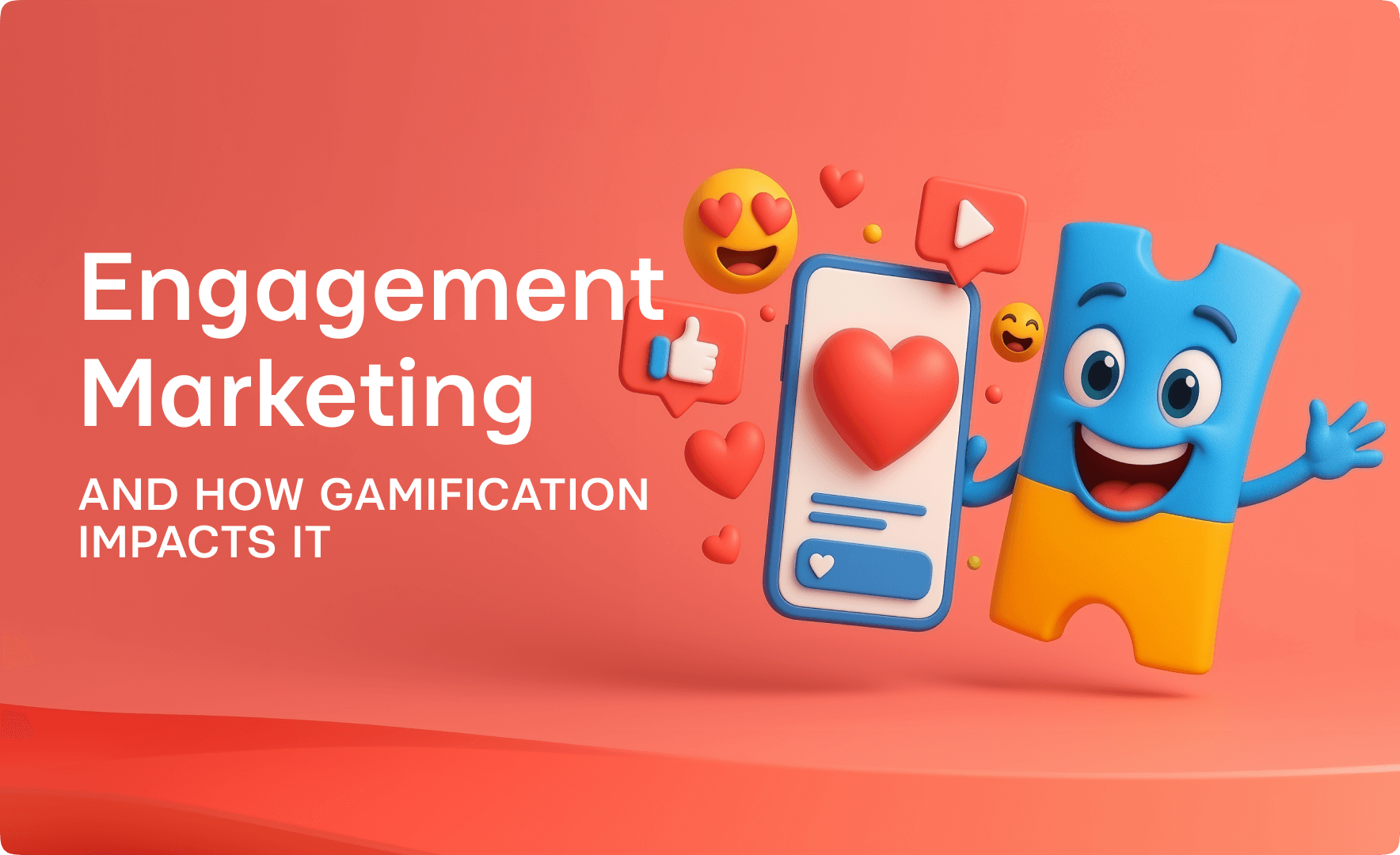How Gamification Transforms Marketing

Market giants like Temu or McDonalds recognized the importance of gamification in marketing long ago, and we can all see the results of their efficient strategies. Temu’s gamified and addictive shopping experiences boosted user engagement, while McDonald’s Monopoly game significantly increased their sales.
In simple words, gamification means gaming mechanics implementation – like points, challenges, rewards, and leaderboards – into marketing operations, leading to increased user engagement and retention. More and more businesses implement gamified elements into their marketing operations, according to recent surveys, almost 70% of Global 2000 companies use gamification.
The widespread adoption of gamification bears fruits because it aims at the deep psychological motivators, improving user engagement, customer loyalty, and brand recognition. So, here we want to show you how gamification can transform your marketing for good.
Achieve Better Marketing Results with Gamification
Check out how gamified campaigns drive conversions and brand loyalty. Book your personalized demo and see how Winday helps you engage more customers.
book a personalized demoWhat is Gamification in Marketing?
Gamification for marketing means the implementation of gaming features and elements into traditional marketing campaigns in order to make it much more efficient through engagement and entertainment. Usually, gaming mechanics used in marketing consist of integration points systems, leaderboards, dynamic challenges, and rewards for activities established by marketers.
By implementing gaming elements into marketing operations, marketers transform them into mini-games that entertain users, making fun experiences and improving brand loyalty. Gaming features turn customers into participators in the processes, fostering deep bonds between the audience and the organization. So, now we’ve made it clear “what is gamification in marketing”. But why make your life more difficult by diving into such complex topics as gaming elements if you’re just a marketer?
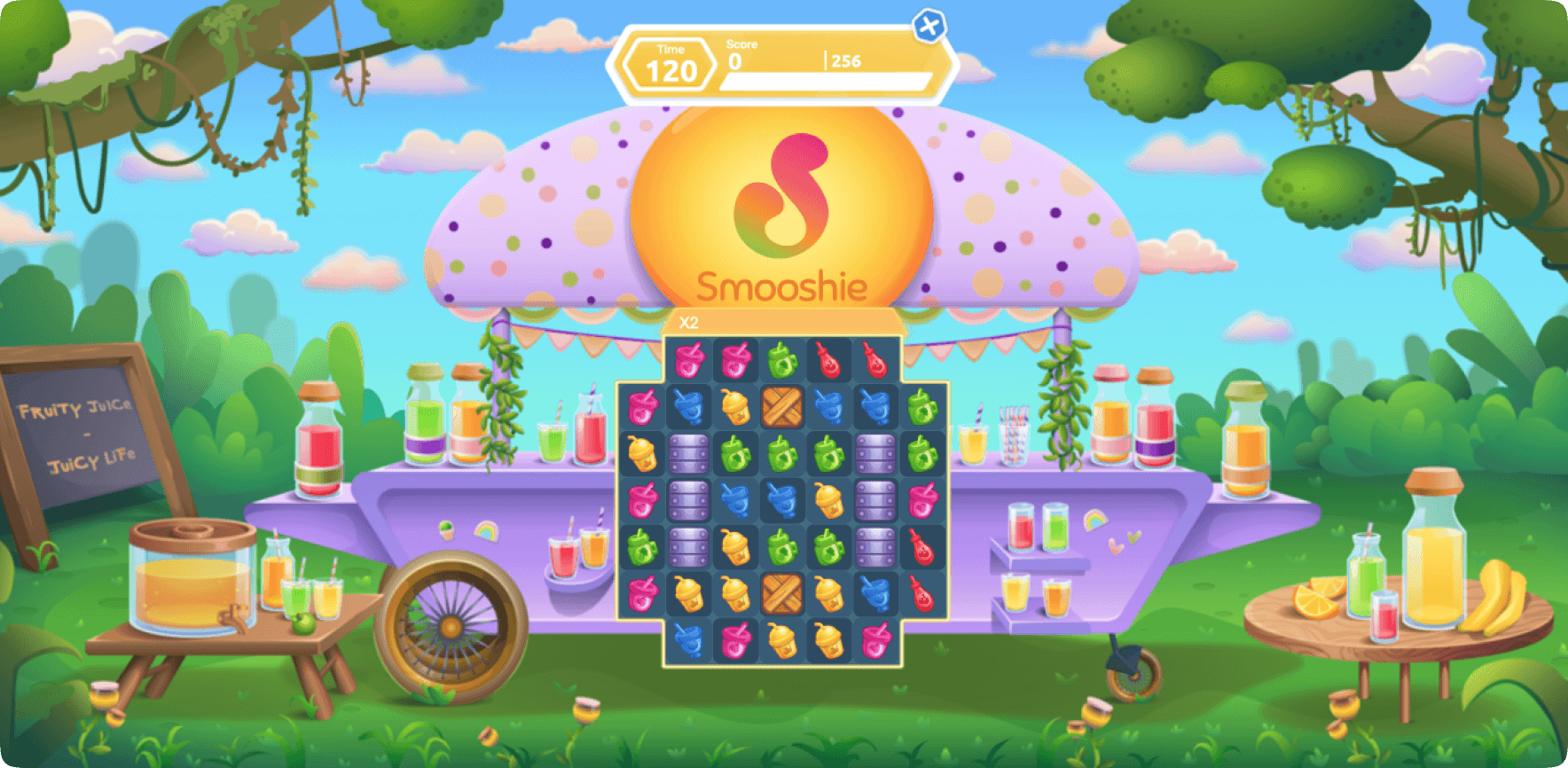
Example of a marketing game for the Smoothie brand.
Well, it’s no secret that traditional marketing strategies, like ads and email campaigns, struggle to capture users’ attention and keep user retention. Modern, noisy, and overcrowded digital landscapes made traditional marketing strategies very challenging. In such a competitive environment, marketers have to find new ways of user engagement, and gaming features are the best solutions for their hurdles.
💡 Did You Know?
Gamification increases user engagement by almost 100%-150% compared to the traditional marketing activities. According to AmplifAI.
Gamification marketing principles are deeply connected with human psychology, tapping into our desire for achievement, competition, and social recognition. That’s why gamified marketing isn’t just about entertainment, it’s about capturing attention and building long-term customer engagement.
The rapid rise of mobile devices and social media in our daily lives is also changing marketing strategies and how gamification techniques can be applied. Social media and mobile devices are the perfect platforms for running gamified campaigns because they’re widely used and highly engaging. Today, almost each business can set up and launch a gamified campaign to attract new customers, retain existing ones, and ultimately boost sales and revenue.
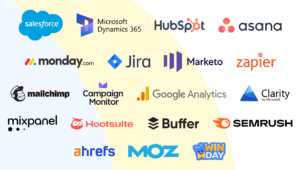
How does gamification in marketing work?
The roots of gamification marketing success lie deep in human psychology. By affecting fundamental, primordial motivators, gamification drives people’s engagement and behavior. Usually, human motivation is divided into two levels: intrinsic and extrinsic, and additionally affected by a dopamine effect. Game developers know it very well and target their gaming mechanics right into the human brains to drive users’ engagement. Read our other material connected with psychology behind gamification and briefly break down these motivators.
- Intrinsic Motivation means inner human desires and basic needs, such as a sense of achievement, competition, and curiosity. When specialists gamify operations, they purposefully create challenges, leaderboards, and progress tracking, encouraging users to participate in marketing activities, and stimulating them to overcome obstacles and accomplish their goals.
- Extrinsic Motivation means achieving external goals, like winning a competition and being rewarded for it. To target extrinsic motivation and stimulate participation, game developers and marketers use reward systems, discounts, exclusive perks, and loyalty points.
- The Dopamine Effect means getting a dose of dopamine hormone in the brain when the user gets small wins or reaches another milestone. Dopamine is like a drug that drives users to continue the activity that brings more and more dopamine, building an addictive process.
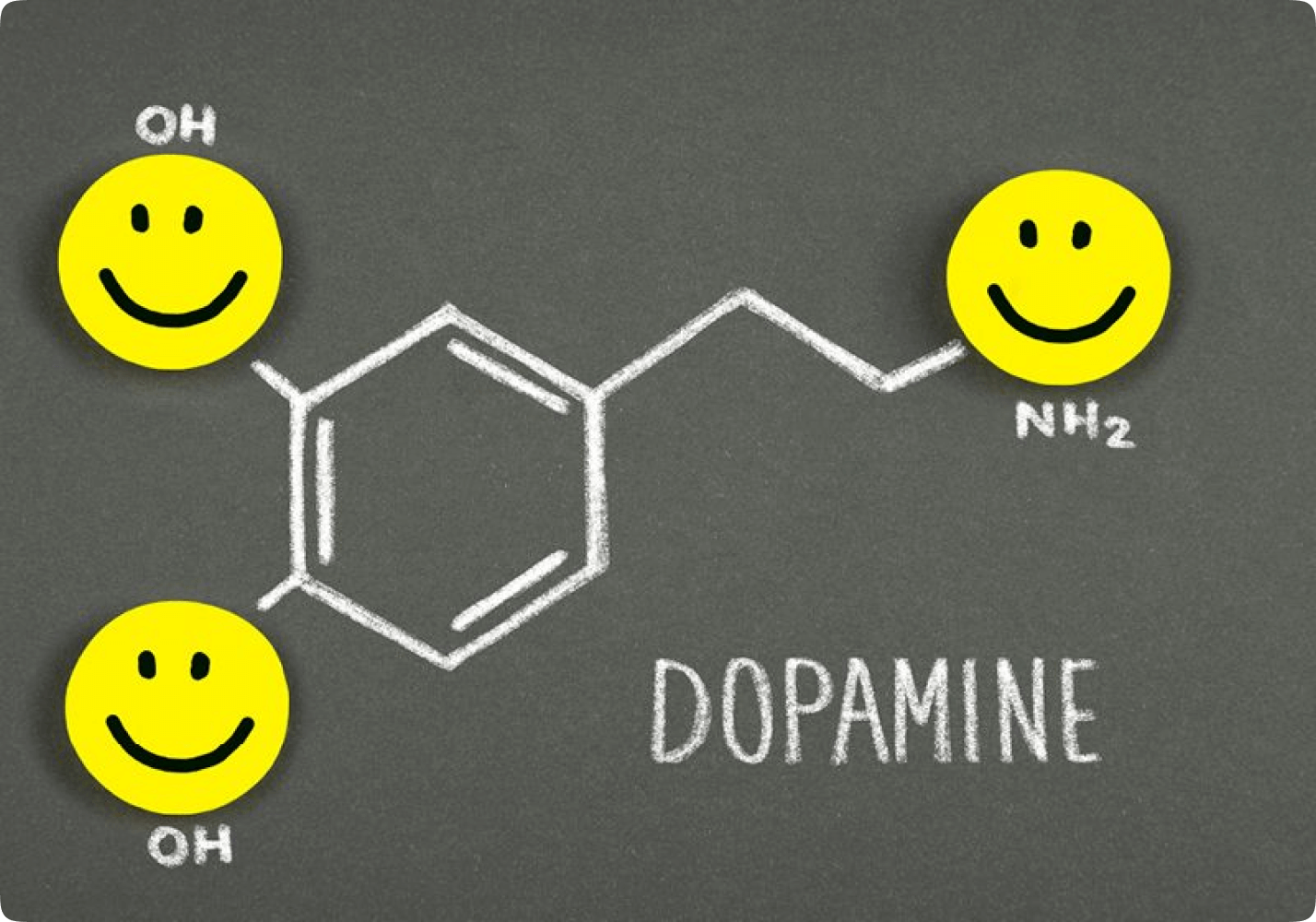
The dopamine hormone that drives people’s engagement.
Interesting fact:
Implementing rewards and winning elements in strategies resulted in a 60% increase in customer engagement.
Recent studies show that the gamification market is only growing and 93% of marketers are leaning towards implementing gamified strategies into their marketing campaigns because audiences like interactive gamified content rather than traditional static one.
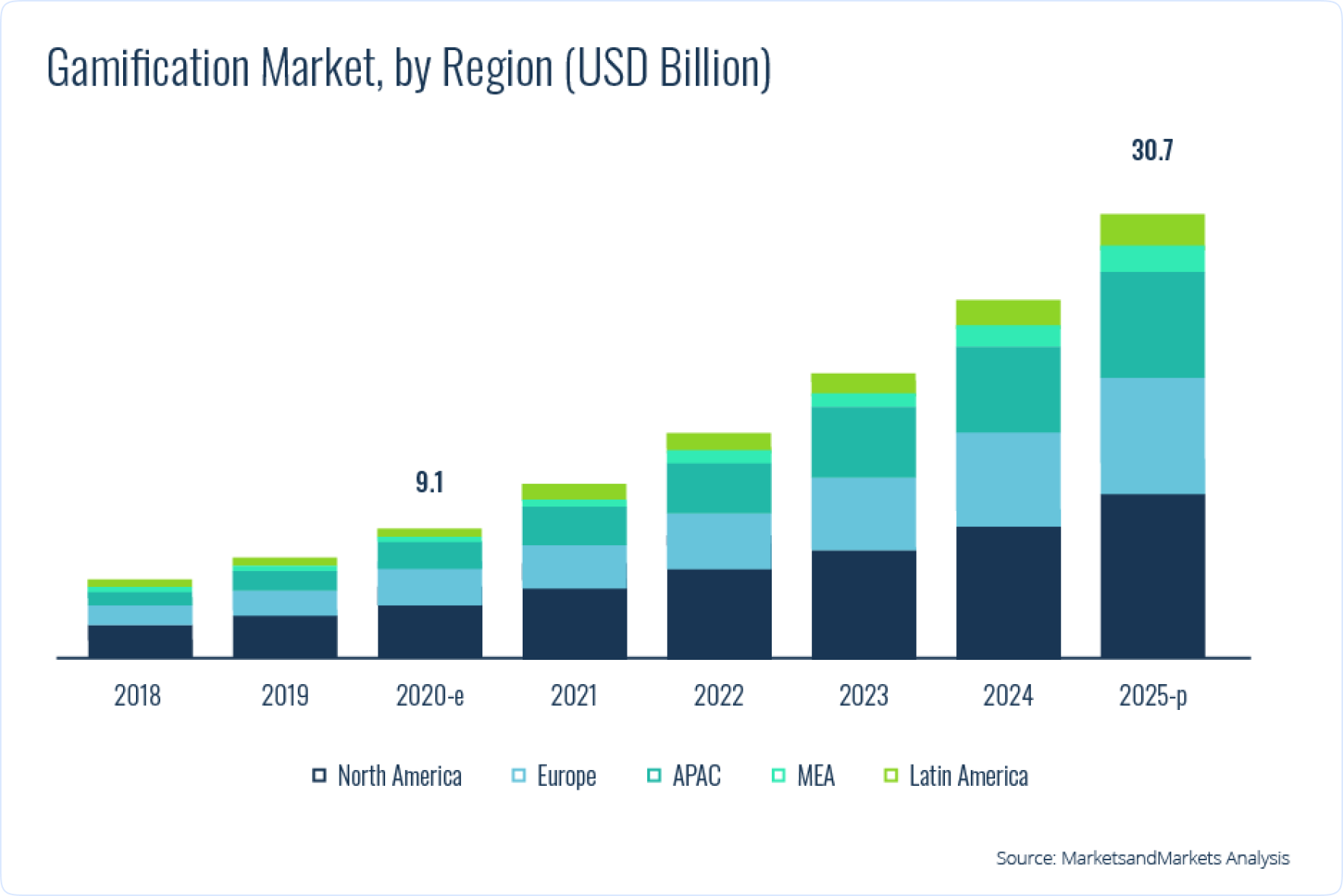
Growth of the gamification market.
Emotional Engagement through Rewards
Rewarding systems are one of the main pillars on which gamification marketing stands. Everyone likes to be rewarded for some achievements, and marketing specialists aim for this driver when creating their campaigns. Rewards give users a sense of achievement and allow them to be proud of themselves. This, in turn, builds a deeper connection between the appreciated user and a brand that gives rewards. Earning rewards is a dopamine trap that captures users and keeps their attention on the brand.
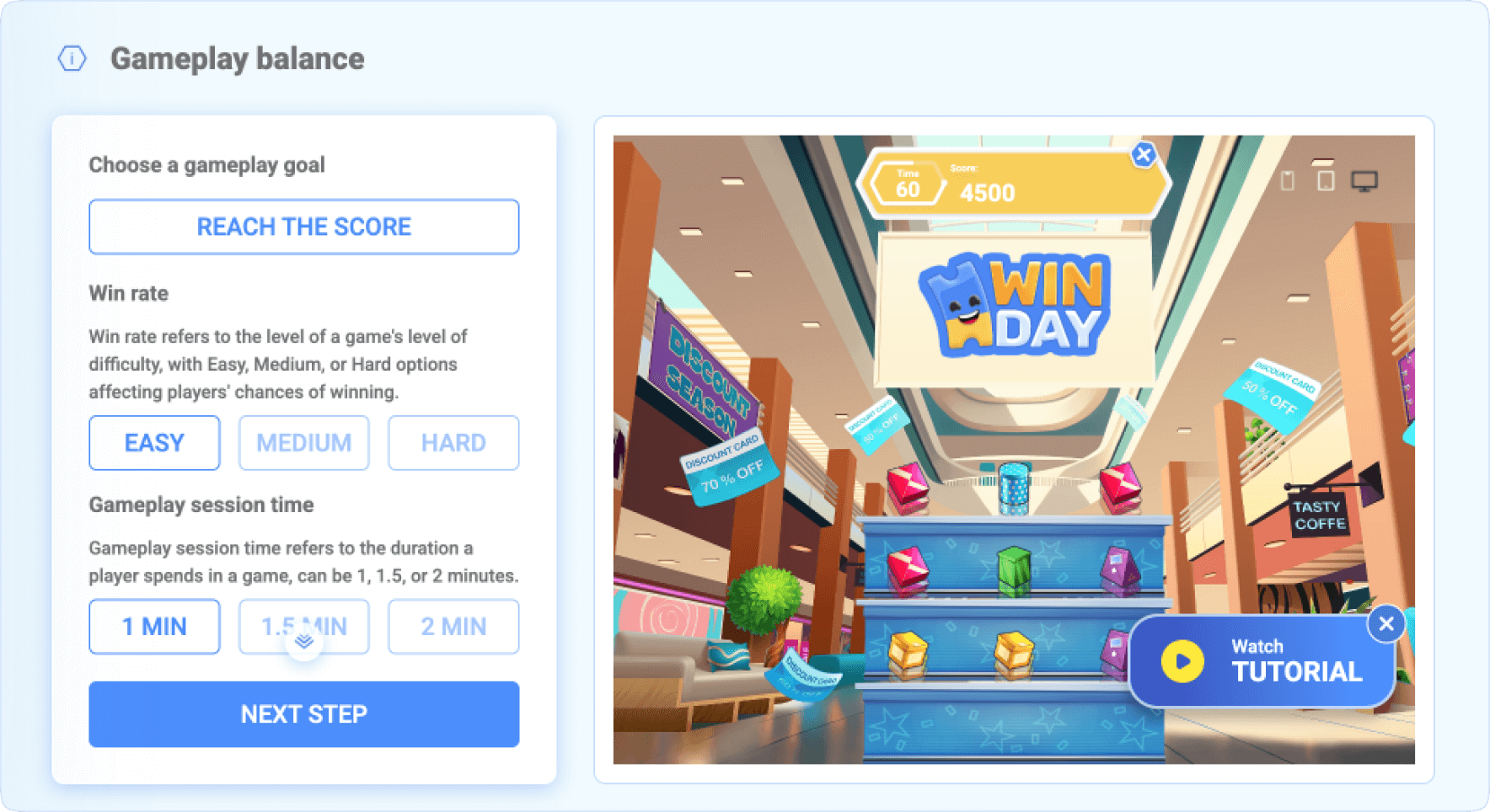
Creating a game on Winday platform.
Among the most popular rewards that leveraged in gamification, you may find the following:
- Points & Levels. Systems with points and levels create a feeling of a journey, process, and progression, which leads to the continuous interaction of users with your brand. For instance, the Nike Run Club uses badges and achievement levels to reward runners for activities and milestones.
- Time Limited Discounts. A powerful tool that drives users crazy. By limiting the time of discounts, you create pressure on the user and a sense of urgency for decision-making. A great example of implementing time-limited discounts is Temu, an e-commerce giant, that continuously offers limited discounts and referral bonuses, enabling customers to quickly purchase products.
- Exclusive Discounts. Another approach that fosters brand loyalty is VIP benefits for special users. Exclusive discounts can be a reward for gamified activity, like in the McDonald’s Monopoly game, when they offer prizes through the gaming experience.
Boosting Customer Loyalty with Interactivity
Interactivity is a crucial aspect of gamification email marketing that entertains users and drives customer loyalty. According to Epsilon, almost 80% of customers prefer brands that offer interactive experiences. To build a robust, dynamic, and engaging user experience, specialists create different gamified interactions, like quizzes, challenges, and point-based rewards.
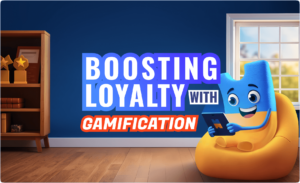
Quizzes & Challenges
Quizzes help marketers gamify regular activities and entertain users, providing them with valuable information. For instance, beauty brands provide personalized quizzes and interactive challenges to recommend customers custom skincare routines tailored to individual preferences and needs. This approach builds trust relationships between the audience and the brand.
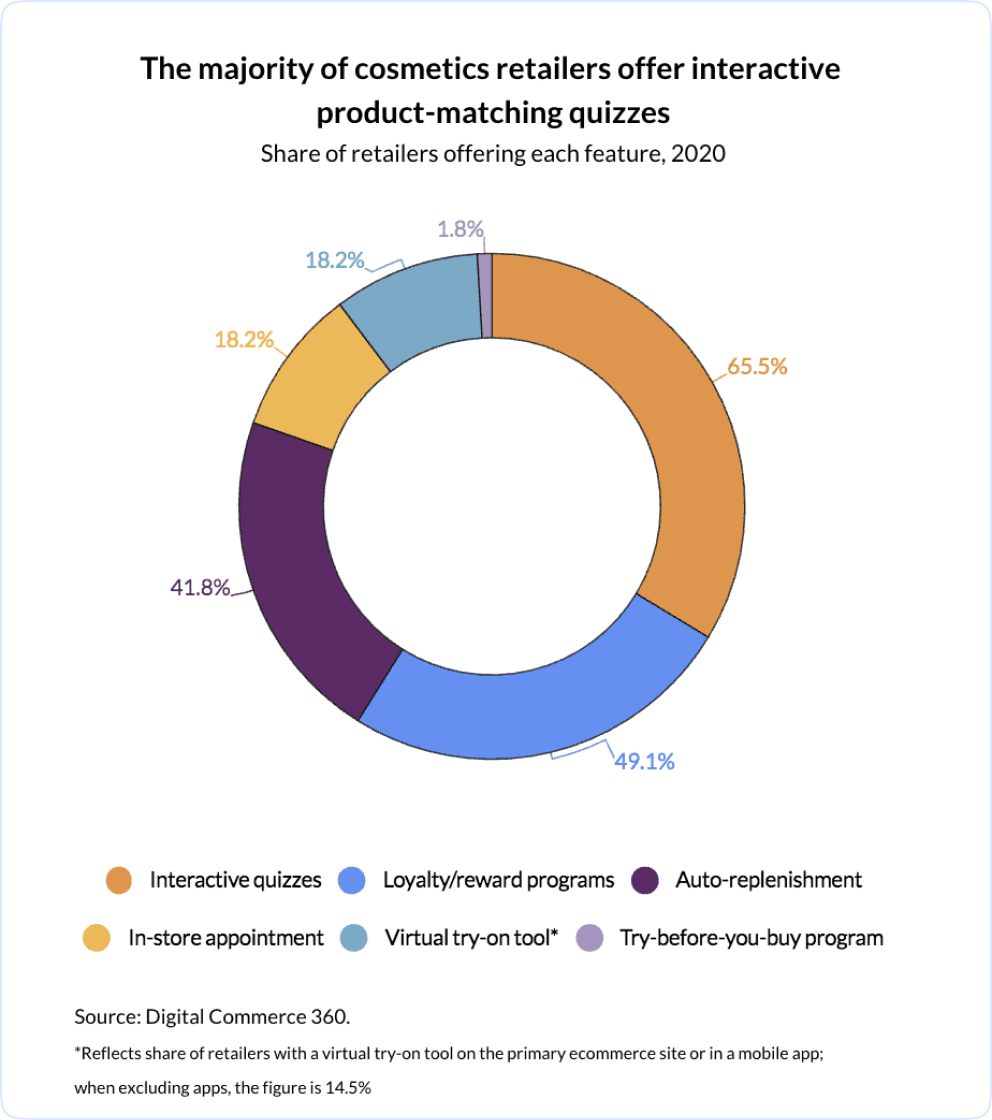
The popularity of interactive quizzes among users.
Point-based rewards
Through point systems, users can track their progress and have a sense of achievement when getting to some milestone, which keeps them engaged. Unlocking new levels through point collection allows users to participate in brand processes and feel involved.
🔝 Useful Tip:
Do not overwhelm users with rewards. While they can create user engagement, they can foster only short-term participation. Hence, it’s important to maintain the balance in rewards.
Instant Games
Winday gamification platform allow organizations to easily create interactive mini-games consisting of basic quests, challenges, and rewards for achievements. Instant Games are great gamification examples in marketing of seamless interactions between the audience and the brand, which boosts user engagement and involvement in the marketing campaign.
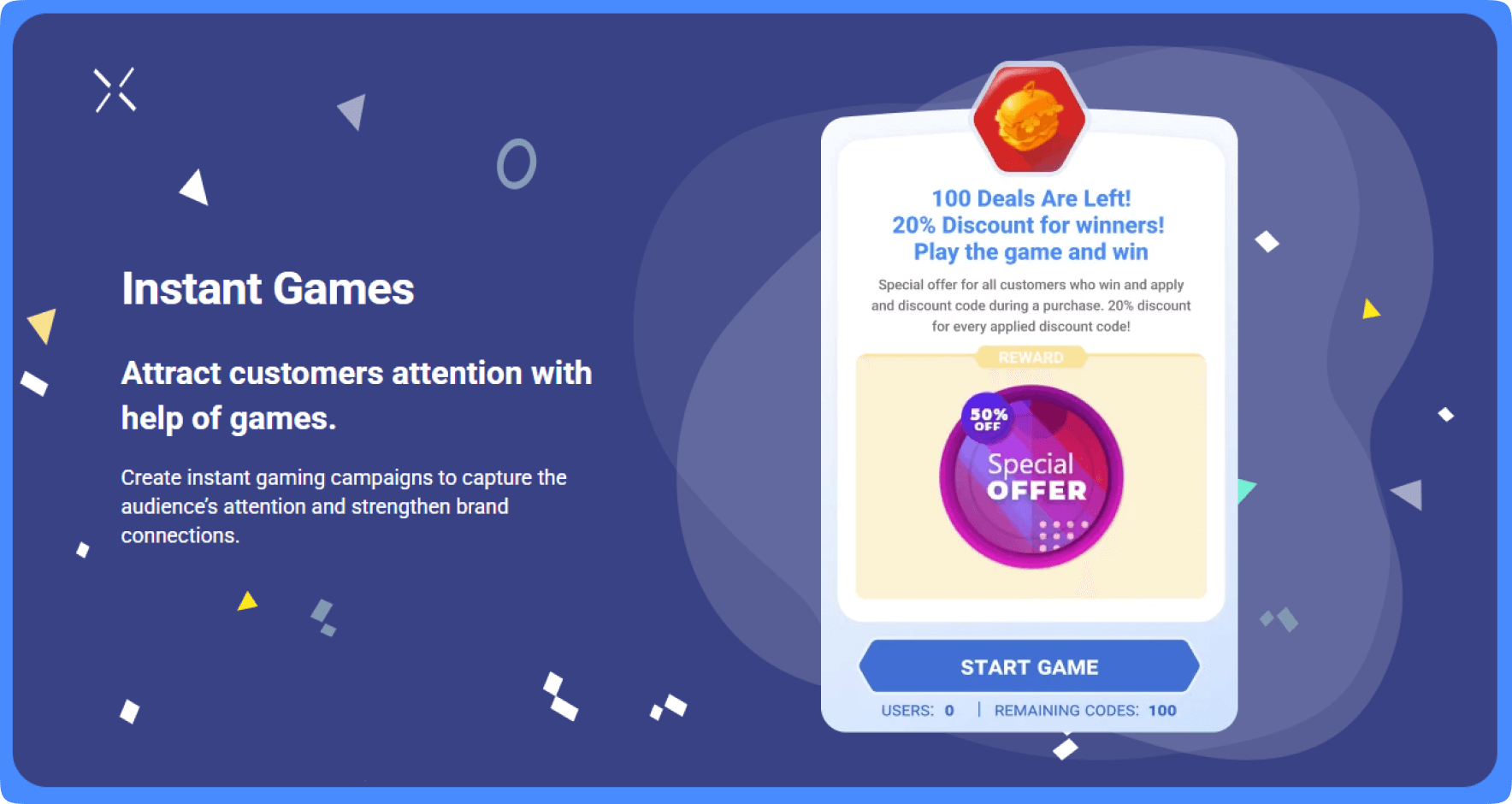
Instant branded game features on the Winday platform.
Social Media and Competitive Motivation
Gamification marketing is a robust, comprehensive tool not only because it engages users through entertainment and interactivity but also because it encourages social sharing and improves the word-of-mouth marketing approach. Gamified mechanics aim at users’ desire for competition and recognition and, consequently, to social sharing of their winnings. By providing users with leaderboards, contests, and rewards, gamification pushes the audience to share their progress on social media, which leads to better brand awareness and visibility.
Leaderboards, contests, and achievements are the three whales on which social media gamification stands. Leaderboards show all the competitors their rankings and results, which fosters competitive spirit and encourages users to outperform their actions. Many gamification platforms offer companies tournament features that allow them to build competitive games in which users participate.
For instance, the Winday Ready-to-go Gamification Platform has a user-friendly tournament creation service, allowing organizations to develop custom tournaments for marketing campaigns. One of the advantages of Winday is that you don’t need technical expertise to develop a tournament game – the platform has an intuitive interface that allows you to create one from scratch easily.
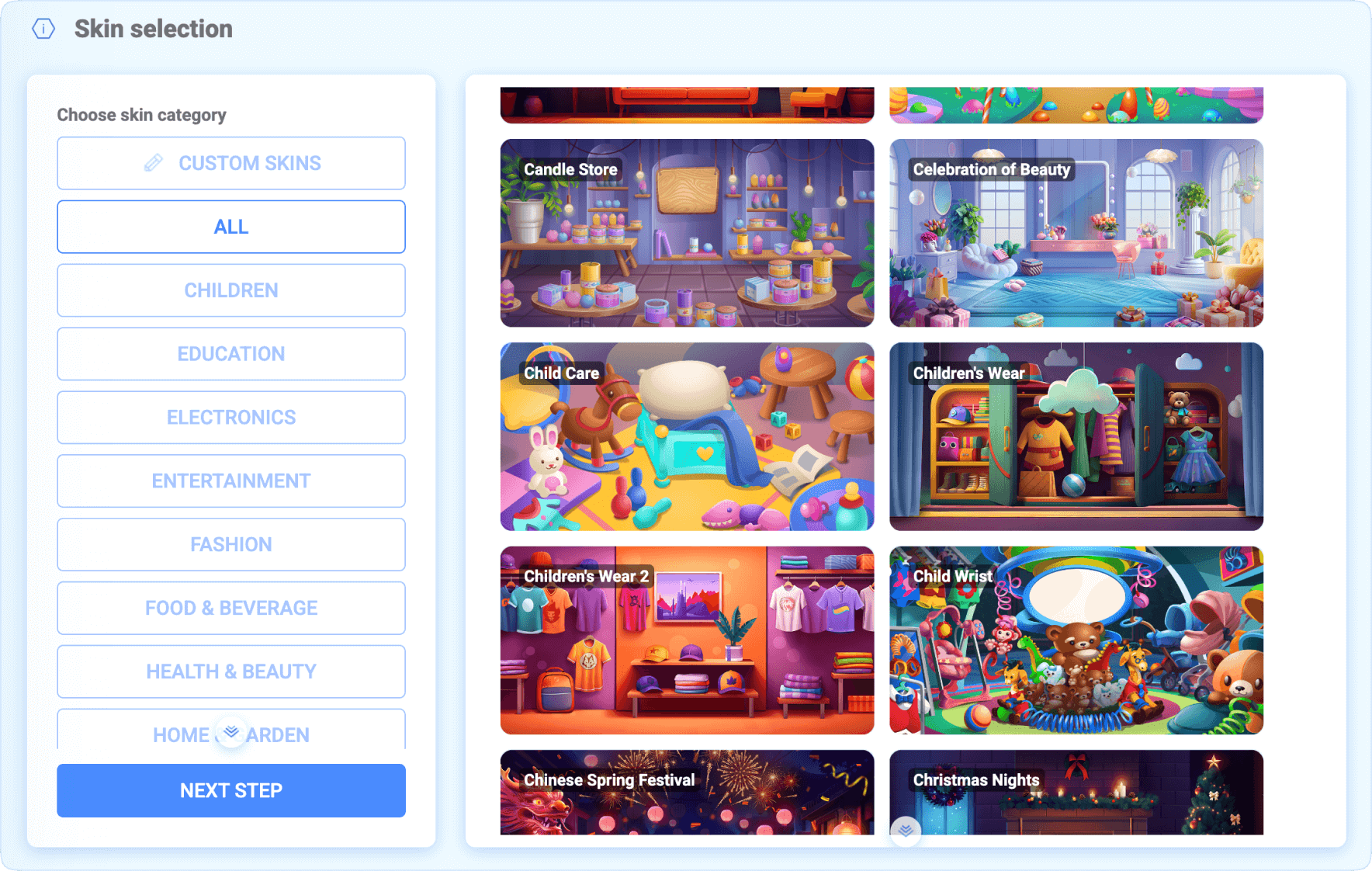
The process of creating the gamified experience with Winday.
Contests also drive user engagement, enabling them to participate in your gamifying activities. Encouraging users with prizes, badges, and rewards, companies engage users in gamified campaigns and boost their retention. These rewards for milestone achievements and winning contests serve as motivators for users to participate in activities and maintain long-term involvement in brand’s operations.
Key Gamification Strategies for Businesses
There are different strategies on how to gamify your marketing campaigns and why. Through implementing point-based loyalty programs, interactive quizzes and polls, contests, leaderboards, and limited-time rewards, businesses significantly enhance their brand presence, recognition, and retention.
Let’s briefly break down each of them:
- Point-Based Loyalty Programs reward users for activity in your campaigns. It’s like giving a carrot in the carrot and stick method. Only without a stick, of course.
- Quizzes and Polls help businesses get valuable insights, create personalized recommendations for users, and build an engaging interaction between your brand and the audience.
- Building a competitive environment through leaderboards and contests boosts user engagement and their involvement in your brand. Your business becomes a playground for the competition which is beneficial for your user retention and brand recognition.
- Limited-Time Rewards create a sense of urgency, encouraging users to participate in activities and increase user engagement.
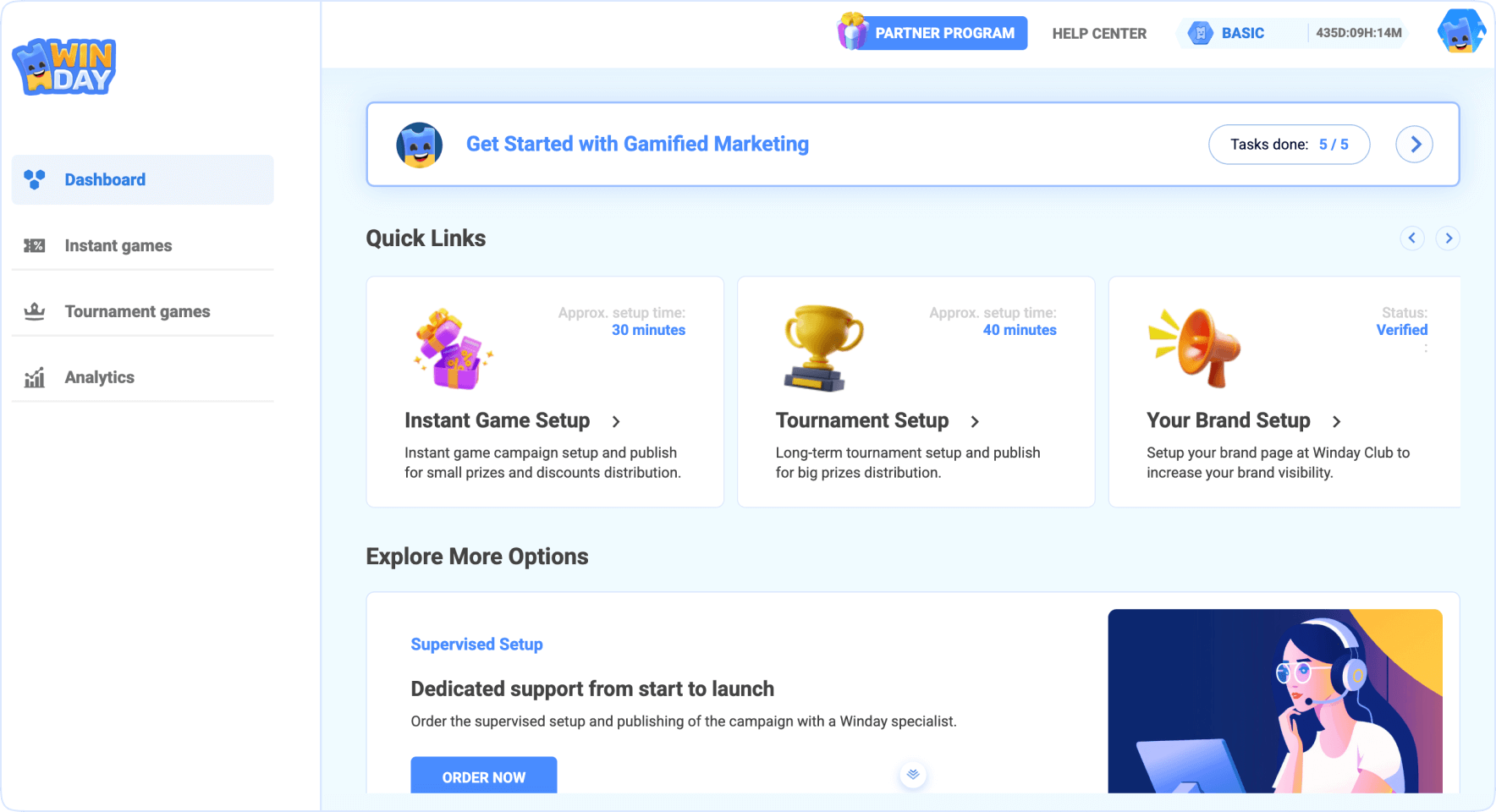
Dashboard of the Winday gamification platform.
🔝 Useful Tip:
Gamified loyalty programs allow businesses to increase customer retention by up to 22%.
Gamify Your Content Marketing
To remain competitive in the modern digital landscape and keep users engaged with your brand, gamification for marketing is a must. By implementing gamified mechanics into your blogs, videos, and educational materials, you create interactive, immersive experiences that capture users and keep them engaged and entertained. As a result of gamified marketing campaigns, organizations boost user retention, engage audiences into participation, and ensure word-of-mouth spreading.
Companies apply different gamification strategies in their campaigns. The most efficient and popular are achievement badges, video challenges, and interactive quizzes and polls. By adding quizzes to your gamification content marketing you encourage your audience to interact with your brand, check their knowledge, express opinions on something, or share their preferences which helps you to build more personalized recommendations.
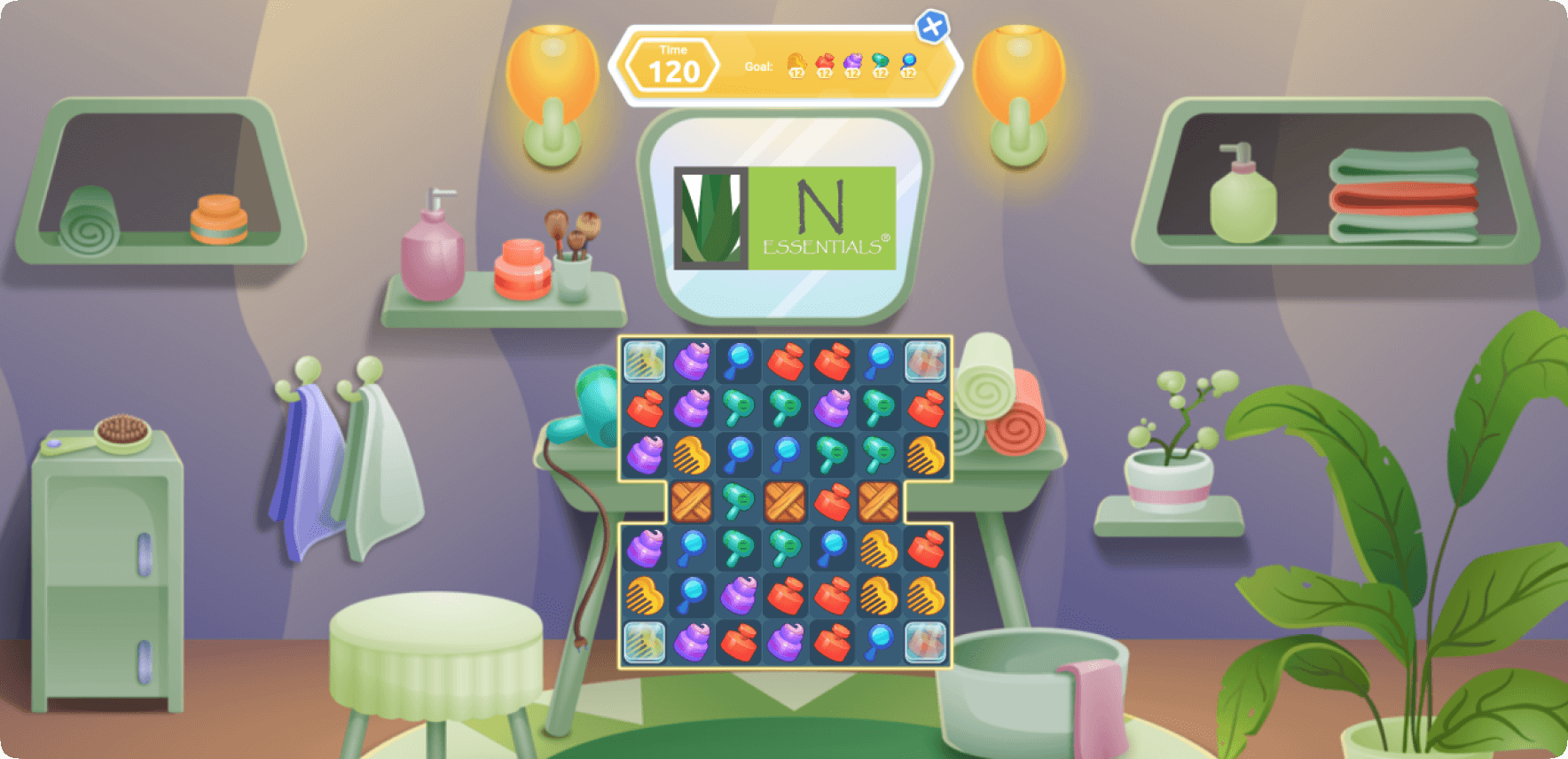
Example of a marketing game made on the Winday platform.
One of the most efficient cases of implementing quizzes is BuzzFeed, which makes reading articles into interactive experiences that help users understand the topic better and keep them involved.
Our advice to you is to leverage tools like Typeform or Playbuzz to implement quizzes and polls into your operations, including marketing campaigns. The best thing about these tools is that they don’t require you to have a robust technical background. You can use them without any technical knowledge and still efficiently integrate quizzes into your company.
Interactive Marketing Games for Lead Generation
When lead generation becomes more and more challenging, gamified elements and interactive marketing games save the day. Through engaging fun factors, entertainment, and generous rewards, marketing games motivate users to participate in activities and share their contacts with valuable information. Each type of marketing games makes lead generation smooth and efficient by using tournaments, instant games, spin-to-win mechanics, and scratch games.
- Instant Games & Tournaments. Building a competitive environment through leaderboards and challenges implementation, you encourage your audience to compete and climb up to the first place and win rewards. One of the great examples of gamification in marketing by using tournaments is one that the Winday platform offers to clients. They integrate tournaments as the element of effective coupon marketing strategy from brand affiliate programs that allow them to send enticing offers to users during the games, improving leads and conversions.
- Spin-to-Win Mechanics. A spinning virtual wheel that allows users to win perks like discounts and loyalty points from your brand is a real dopamine machine. As in casinos, spinning wheels create exciting, addictive experiences for users, motivating them to stay with your brand and share their info, which is very beneficial for your business.
- Scratch Cards. It’s a very simple mechanic that easily and quickly improves lead generation. By scratching virtual cards, your audience can get hidden rewards and share their contacts. Scratch cards can significantly enhance your marketing database.
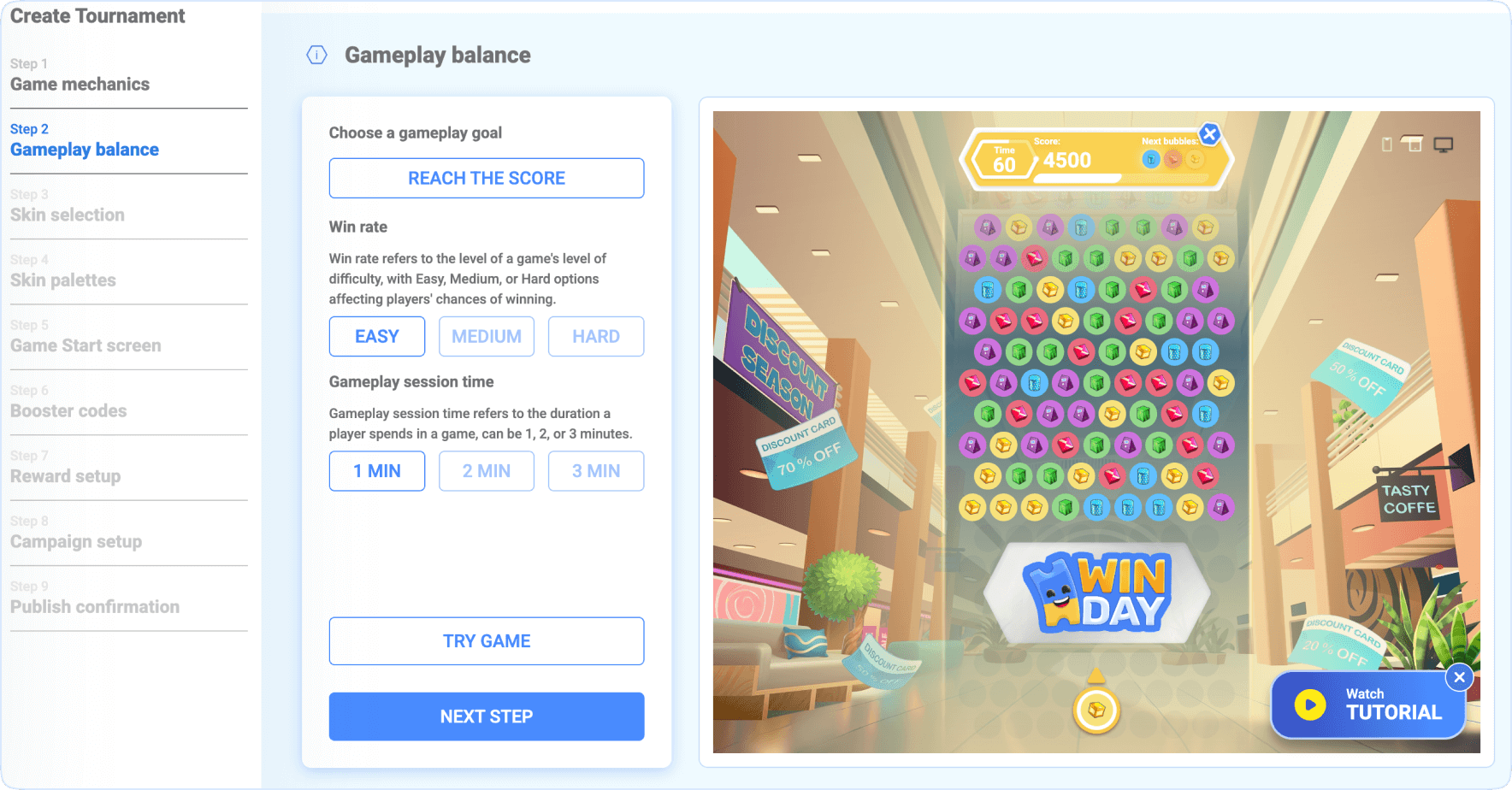
Tournament game creation on the Winday gamification platform.
Gamification in Social Media Campaigns
Nowadays, social media is the main playground for marketing operations. Facebook, Instagram, and TikTok completely reshaped the marketing approaches and became a perfect spot for gamified campaigns. Game-like mechanics on social media platforms allow businesses to boost user engagement and improve retention, and audience loyalty. Usually, marketers use hashtag challenges, story-based quizzes, polls, and even user-generated content contests. Let’s look at the most successful cases of deploying these mechanics on social media gamification.
One of the great gamification examples in marketing of leveraging hashtag challenges is TikTok’s viral branded challenges. Giving a special hashtag for a video with some dance, meme, or trend creates a viral experience that spreads around the world, gathering millions of users around the single trend. It’s a new pop-culture phenomenon that businesses tend to use for marketing reasons.
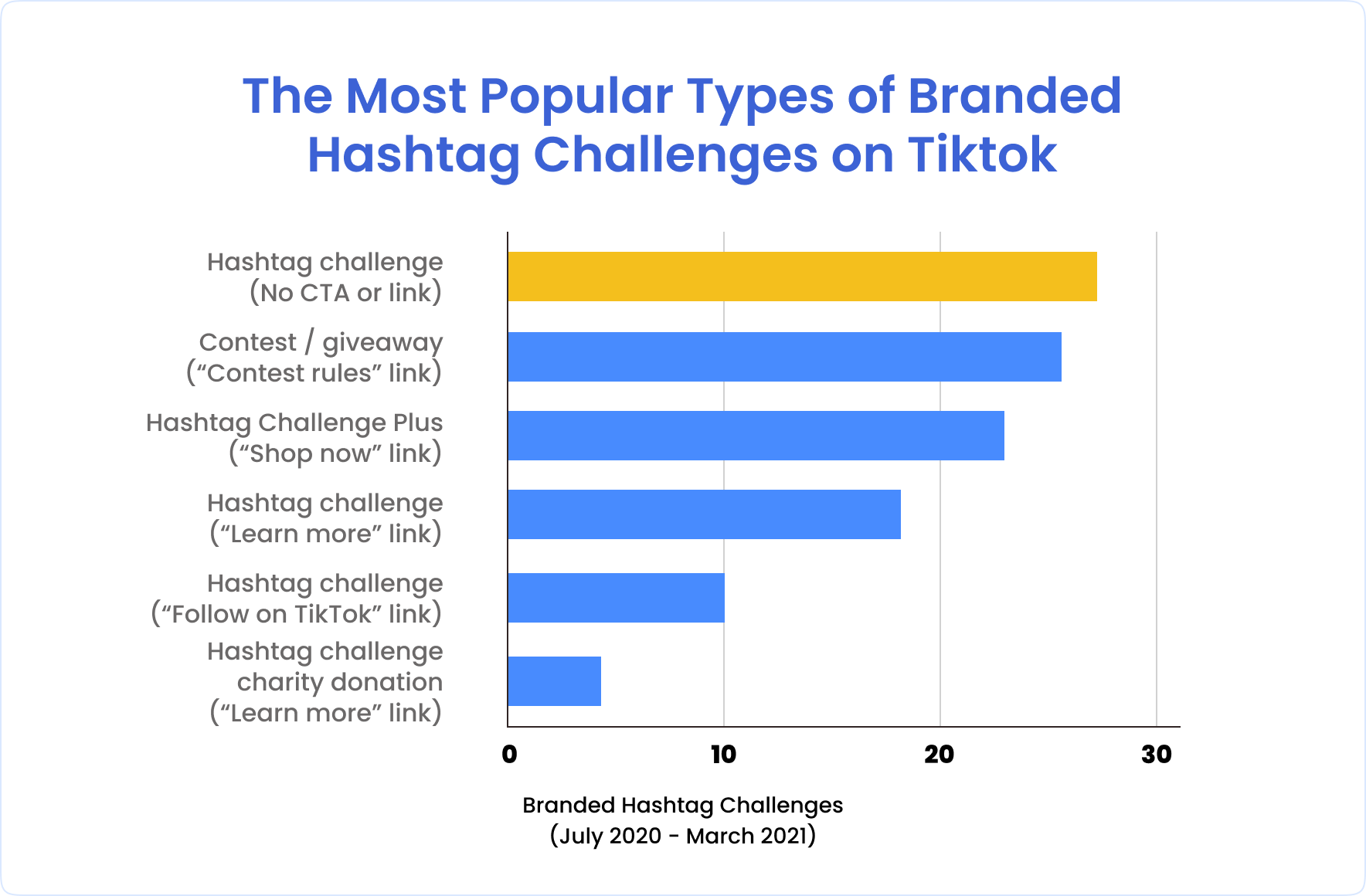
Branded hashtag challenges on TikTok.
Story-based quizzes are perfectly utilized on Instagram, where the platform offers users interactive stickers that can be used over the content gamification. It might be polls, quizzes, and emojis that allow followers to answer questions, vote, and share their opinions. This simple, yet efficient mechanic gamifies static content and creates an interaction between the brand and followers, allowing businesses to easily gain valuable insights and feedback from the audience.
Marketers also conduct User-Generated Content (UGC) contests to engage users in competition and turn them from silent observers into participants in the activities. One of the examples of gamification in marketing is Nike’s #RunForIt challenge involved runners who took pictures while jogging. The authors of the most beautiful shots were rewarded by Nike with exclusive products. It was a great campaign that engaged thousands of people to share their UGC and promote Nike.
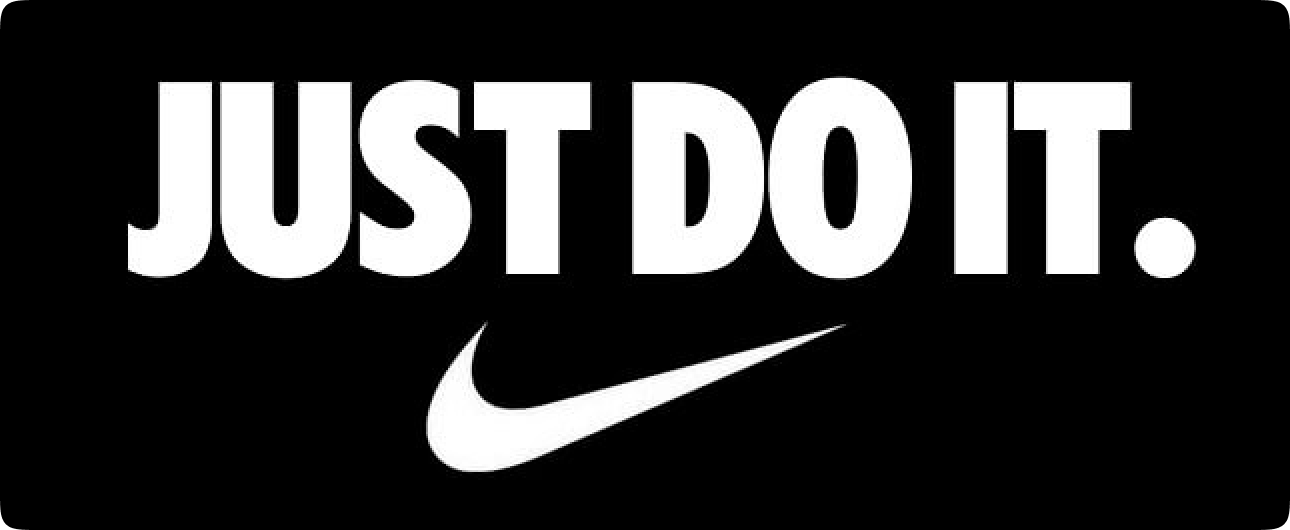
Nike’s Just Do It marketing campaign.
Gamification platforms like Winday offer clients the opportunity to create custom instant games and tournaments that can be directly implemented on social media. These gamified tournaments efficiently engage followers on social media platforms and improve your user retention. Additionally, the integration of the affiliate links allows you to generate income through brand-sponsored rewards.
Benefits of such gamifying operations are clear:
- Next-gen Engagement. Gamified marketing activities turn users into participants that have fun and entertained, fostering deeper and long-term user engagement.
- New Way of Monetization. Affiliate programs allow brands to establish additional income through commissions while promoting interactive experiences.
- Robust Community. Gamification creates a strong community around your mini-games, interactive campaigns, and your brand.
Winday Platform for Gamified Marketing Campaigns
To seamlessly and effectively gamify your marketing campaign it’s better to approach a gamification platform offering turn-key gamification solutions. Winday is one of the best platforms that provide end-to-end gamification solutions for businesses that struggle to gamify their operations on their own. Winday turns your classic marketing activities into fun and engaging experiences that attract, capture, and convert users by using mini-games and interactive solutions.
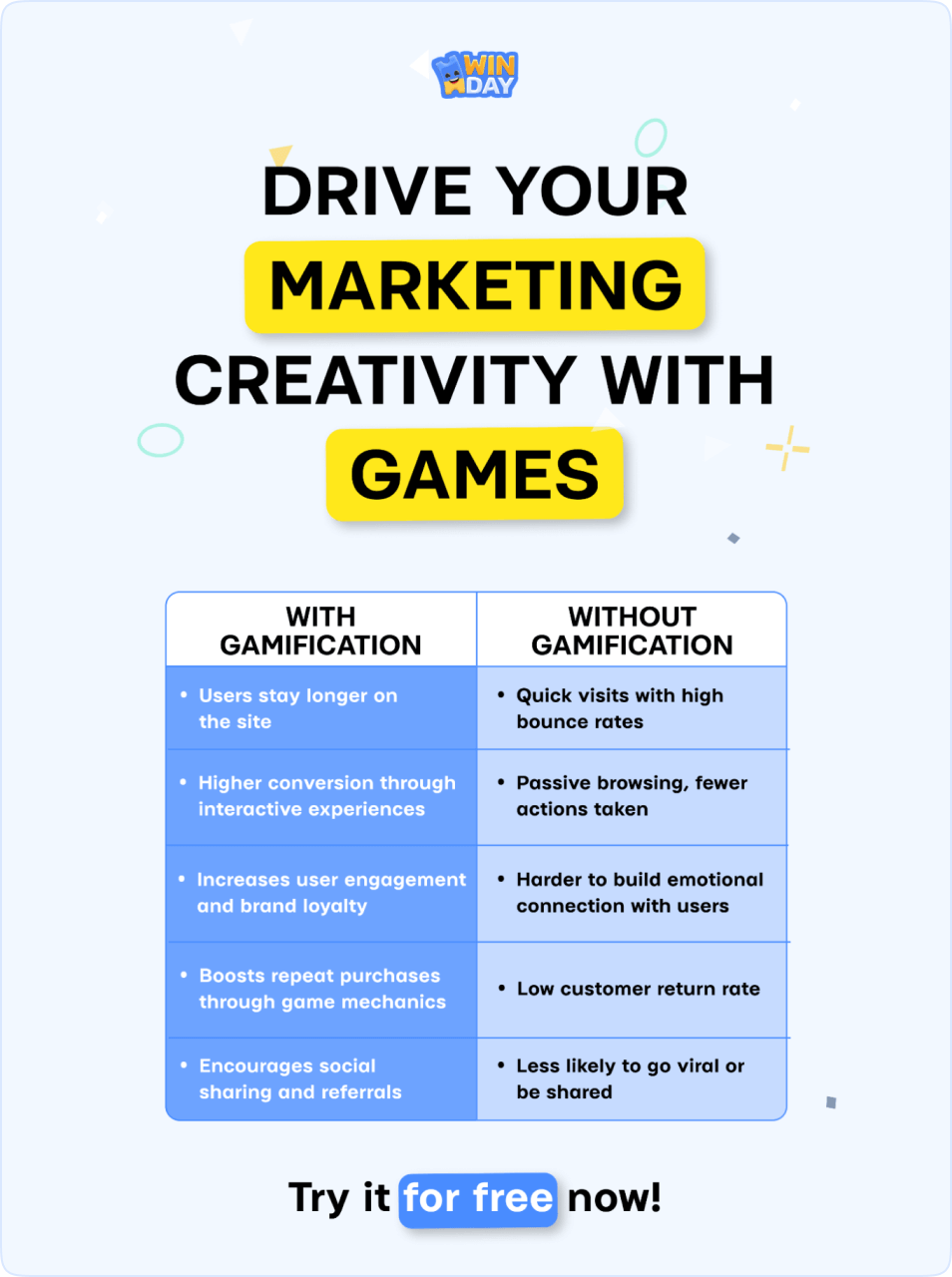
Winday is the ultimate platform for Gamified Marketing Campaigns.
Among a wide range of Winday advantages that make it the best gamification platform for businesses are the following:
Diverse Gameplay Options
In the Winday arsenal, you may find various game types, including instant games with diverse mechanics, like a shooter, draw, or match3, and tournaments to drive users’ competitive spirit. Winday also offers gamification email marketing and customization functions that allow businesses to adjust the game according to industry standards. Whether it’s Fashion, Electronics, Food, Sports, or Healthcare, Winday provides flexibility for any industry.
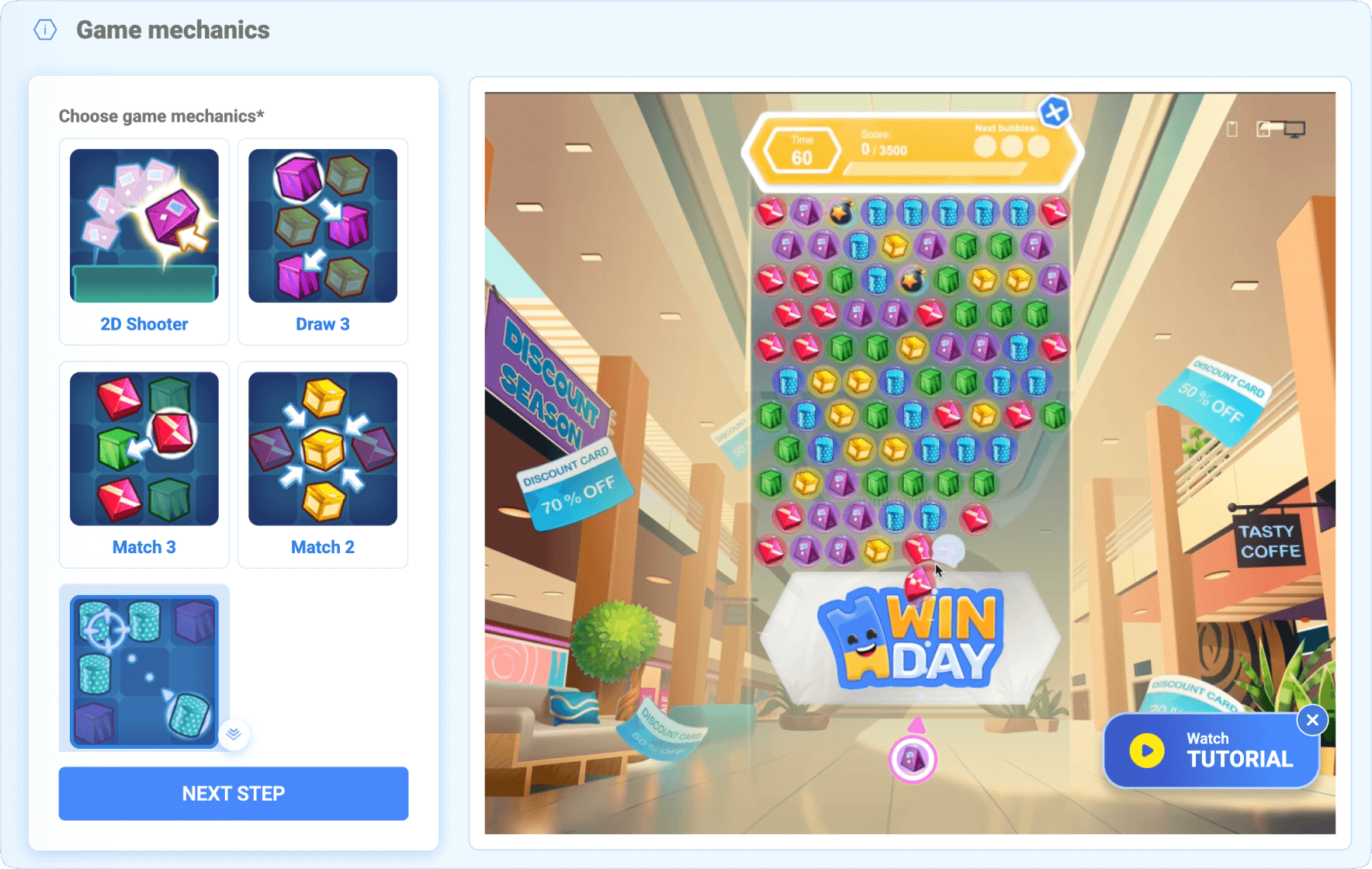
Gameplay mechanics to choose from on the Winday platform.
No-Code Setup for Marketers
It means that you don’t have to have a technical background to gamification strategy with Winday. The no-code functionality and intuitive interface of this platform allow brands to easily craft, manage, and release their gamified experiences.
Campaign Scaling
Winday offers pre-built templates that can be easily integrated into your marketing campaign and adjusted according to your business needs.
Data Tracking
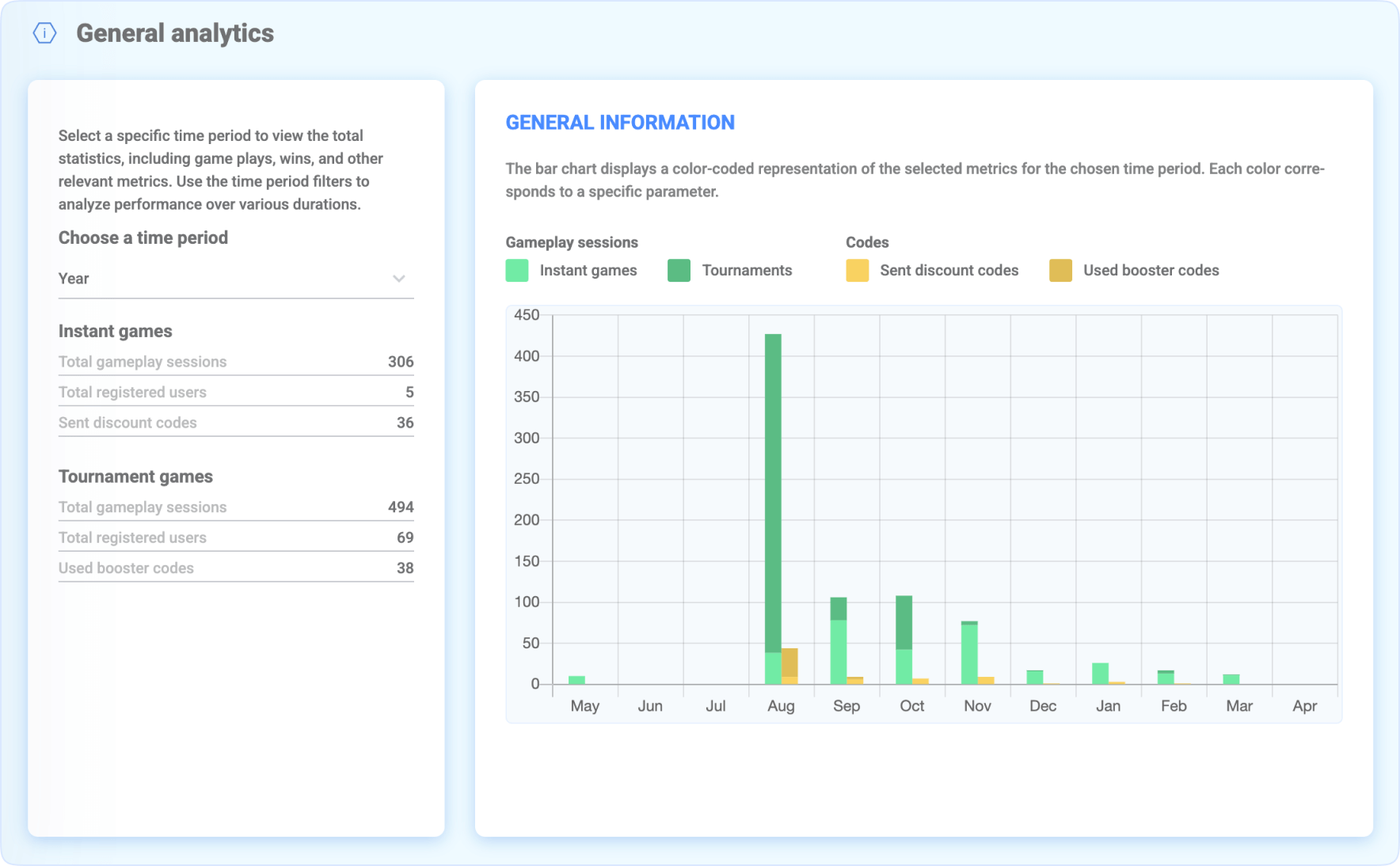
Analytics of the gamified experiences on the Winday platform
Winday offers built-in analytics to track your marketing campaign performance metrics, engagement rates, lead generation, and conversions. You can use this valuable data to adjust the next campaigns and make them more efficient and profitable.
Start Winday Free
Join Winday for absolutely free to figure out the functionality of the platform and create your first interactive, gamified experience!
start your free planRate this article
FAQ
Keep Learning
Marketing Calendar 2025 - Gamified Marketing Campaign Plan
Looking for ways to add gamification on your marketing calendar 2025? Check out our guide to gamified marketing campaigns for the upcoming year.
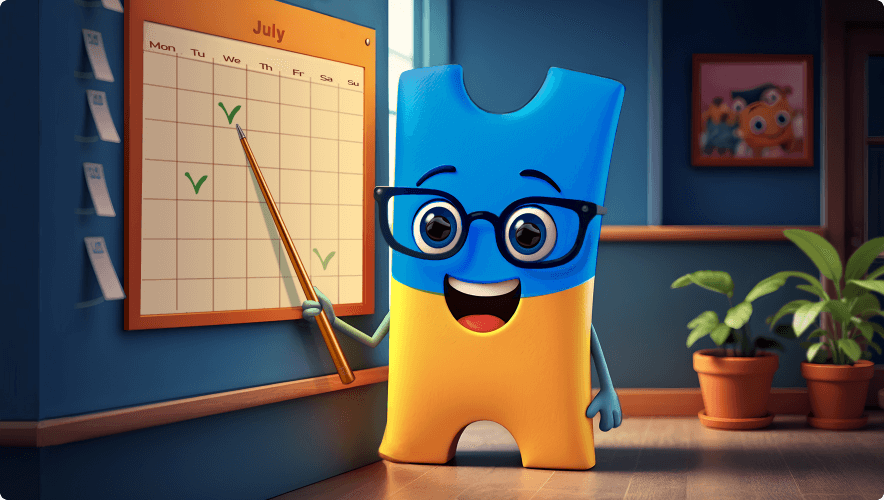
Customer Engagement in Coupon Marketing
Learn what coupon marketing is, what types of coupons fit best for your campaign, and how to boost your coupon campaign with gamification.
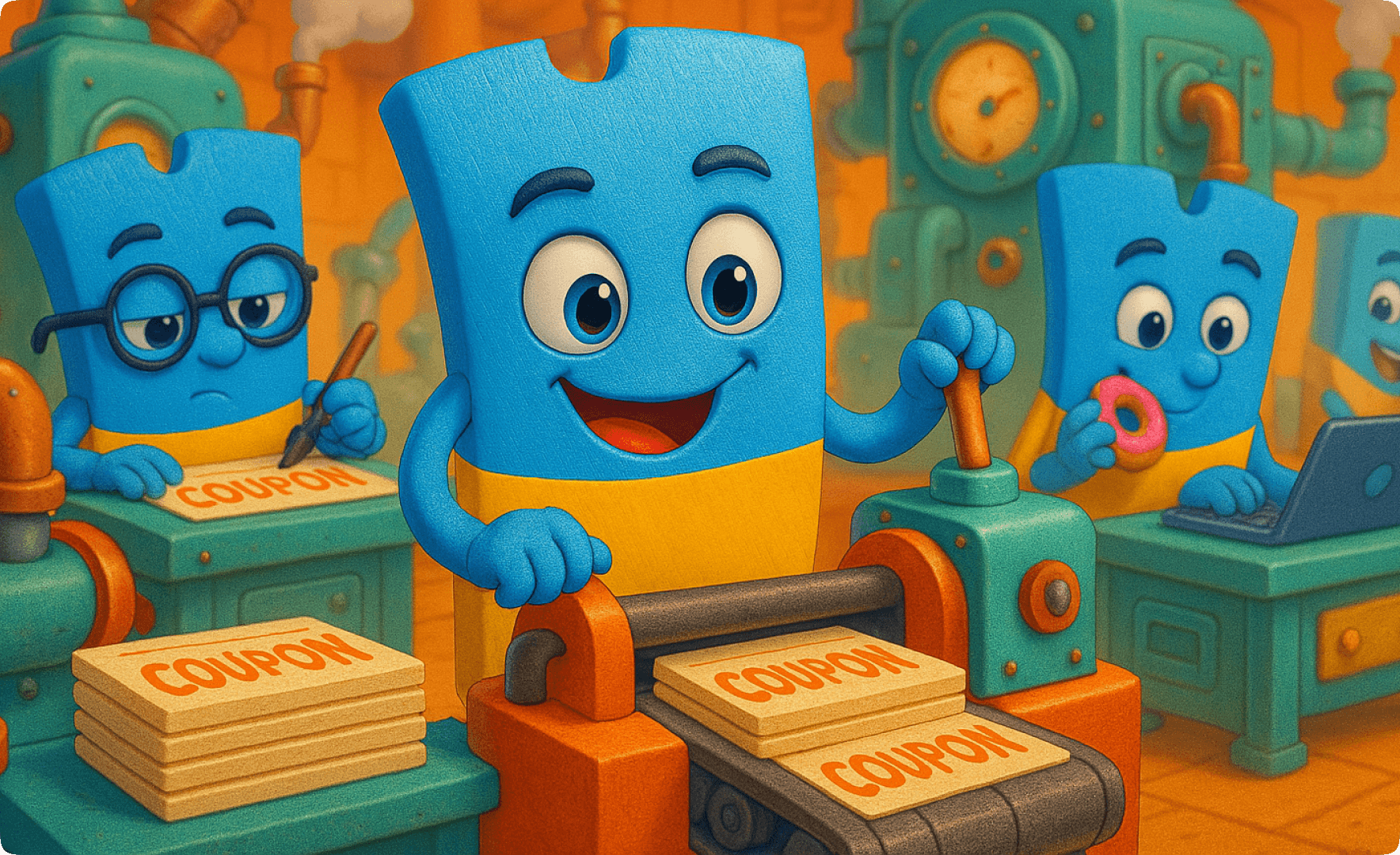
Engagement Marketing and How Gamification Impacts It
Marketing keeps upgrading, and one of its strongest drivers today is engagement. At the heart of it lies gamification. Explore what engagement marketing is, and the options you can get with Winday.
